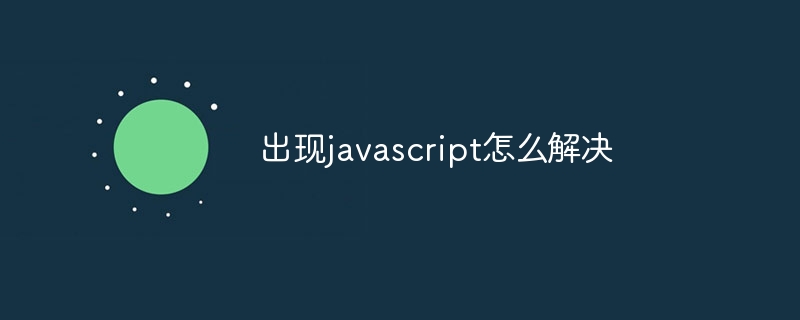How to solve the problem of javascript
In JavaScript, methods for using DOM to process HTML document elements include: obtaining elements (such as getElementById, getElementsByTagName, querySelector), operating elements (such as innerHTML, outerHTML, textContent), and creating new elements (such as createElement, createTextNode ), attaching or removing elements (such as appendChild, insertBefore, removeChild) and event handling (such as addEventListener, re

##How to handle DOM elements in JavaScript ?
Answer: In JavaScript, you can use DOM (Document Object Model) to process elements in HTML documentsSpecific processing method:
1. Get the element
- ##getElementById(id)
- : Get a single element based on its id attribute. ##getElementsByTagName(tagName): Get the set of all matching elements based on the tag name of the element
- getElementsByClassName(className): Get the set of all matching elements based on the class name of the element. .
- querySelector(selector): Use CSS selector to get the first matched element.
- querySelectorAll(selector): Use CSS to select. Gets a collection of all matching elements
- 2. Operate elements
innerHTML: Get or set the inner content of the element. Linked HTML.
- ##outerHTML
- : Get or set the complete HTML of the element, including itself. ##textContent : Get or set the text content of the element. Does not contain child elements.
- value : Gets or sets the value of a form element (such as a text box or drop-down list)
- style : Gets. Or set the style attribute of the element to support inline styles
- ##3. Create a new element
- ##createElement(tagName) : Create a new HTML element.
createTextNode(text): Create a new text node.
- 4. Append or remove elements
- appendChild(child) : Add child elements to the parent element end.
insertBefore(newChild, refChild): Insert the new child element before the specified child element.
- removeChild(child): Remove the specified child element from the parent element.
- 5. Event handling
- addEventListener(type, handler) : Add an event listener to the element.
removeEventListener(type, handler): Remove an event listener.
- Example:
// 获取元素
const element = document.getElementById("my-element");
// 设置元素文本
element.textContent = "Hello World!";
// 添加事件监听器
element.addEventListener("click", function() {
alert("Element clicked!");
});
// 创建新元素
const newElement = document.createElement("p");
// 设置新元素文本
newElement.textContent = "New element";
// 附加新元素
element.appendChild(newElement);The above is the detailed content of How to solve the problem of javascript. For more information, please follow other related articles on the PHP Chinese website!

Hot AI Tools

Undresser.AI Undress
AI-powered app for creating realistic nude photos

AI Clothes Remover
Online AI tool for removing clothes from photos.

Undress AI Tool
Undress images for free

Clothoff.io
AI clothes remover

AI Hentai Generator
Generate AI Hentai for free.

Hot Article

Hot Tools

Notepad++7.3.1
Easy-to-use and free code editor

SublimeText3 Chinese version
Chinese version, very easy to use

Zend Studio 13.0.1
Powerful PHP integrated development environment

Dreamweaver CS6
Visual web development tools

SublimeText3 Mac version
God-level code editing software (SublimeText3)

Hot Topics
 1384
1384
 52
52
 The Roles of HTML, CSS, and JavaScript: Core Responsibilities
Apr 08, 2025 pm 07:05 PM
The Roles of HTML, CSS, and JavaScript: Core Responsibilities
Apr 08, 2025 pm 07:05 PM
HTML defines the web structure, CSS is responsible for style and layout, and JavaScript gives dynamic interaction. The three perform their duties in web development and jointly build a colorful website.
 How to use bootstrap in vue
Apr 07, 2025 pm 11:33 PM
How to use bootstrap in vue
Apr 07, 2025 pm 11:33 PM
Using Bootstrap in Vue.js is divided into five steps: Install Bootstrap. Import Bootstrap in main.js. Use the Bootstrap component directly in the template. Optional: Custom style. Optional: Use plug-ins.
 How to write split lines on bootstrap
Apr 07, 2025 pm 03:12 PM
How to write split lines on bootstrap
Apr 07, 2025 pm 03:12 PM
There are two ways to create a Bootstrap split line: using the tag, which creates a horizontal split line. Use the CSS border property to create custom style split lines.
 How to resize bootstrap
Apr 07, 2025 pm 03:18 PM
How to resize bootstrap
Apr 07, 2025 pm 03:18 PM
To adjust the size of elements in Bootstrap, you can use the dimension class, which includes: adjusting width: .col-, .w-, .mw-adjust height: .h-, .min-h-, .max-h-
 Understanding HTML, CSS, and JavaScript: A Beginner's Guide
Apr 12, 2025 am 12:02 AM
Understanding HTML, CSS, and JavaScript: A Beginner's Guide
Apr 12, 2025 am 12:02 AM
WebdevelopmentreliesonHTML,CSS,andJavaScript:1)HTMLstructurescontent,2)CSSstylesit,and3)JavaScriptaddsinteractivity,formingthebasisofmodernwebexperiences.
 How to set up the framework for bootstrap
Apr 07, 2025 pm 03:27 PM
How to set up the framework for bootstrap
Apr 07, 2025 pm 03:27 PM
To set up the Bootstrap framework, you need to follow these steps: 1. Reference the Bootstrap file via CDN; 2. Download and host the file on your own server; 3. Include the Bootstrap file in HTML; 4. Compile Sass/Less as needed; 5. Import a custom file (optional). Once setup is complete, you can use Bootstrap's grid systems, components, and styles to create responsive websites and applications.
 How to insert pictures on bootstrap
Apr 07, 2025 pm 03:30 PM
How to insert pictures on bootstrap
Apr 07, 2025 pm 03:30 PM
There are several ways to insert images in Bootstrap: insert images directly, using the HTML img tag. With the Bootstrap image component, you can provide responsive images and more styles. Set the image size, use the img-fluid class to make the image adaptable. Set the border, using the img-bordered class. Set the rounded corners and use the img-rounded class. Set the shadow, use the shadow class. Resize and position the image, using CSS style. Using the background image, use the background-image CSS property.
 How to use bootstrap button
Apr 07, 2025 pm 03:09 PM
How to use bootstrap button
Apr 07, 2025 pm 03:09 PM
How to use the Bootstrap button? Introduce Bootstrap CSS to create button elements and add Bootstrap button class to add button text



